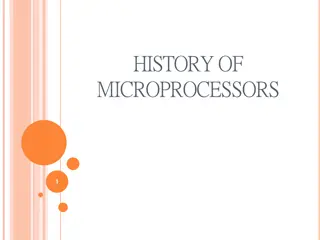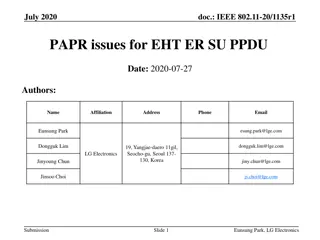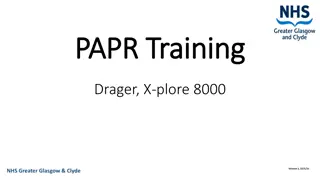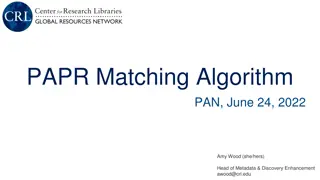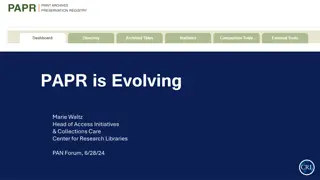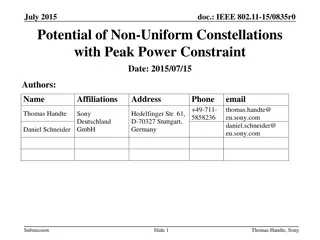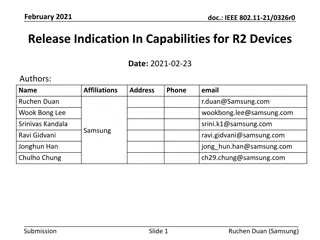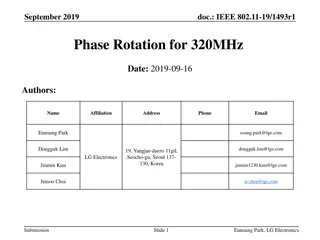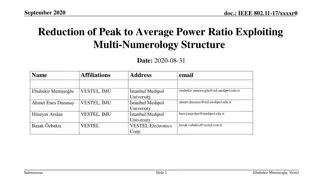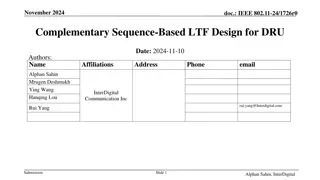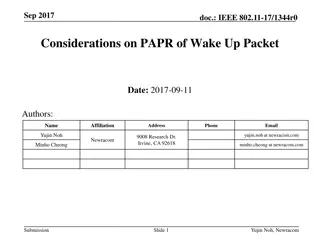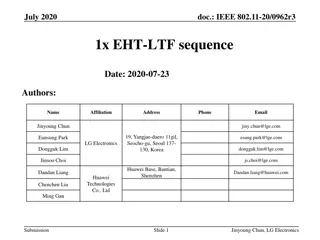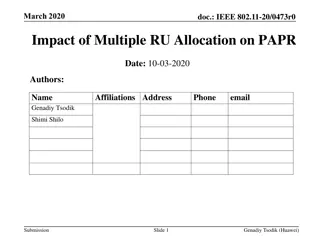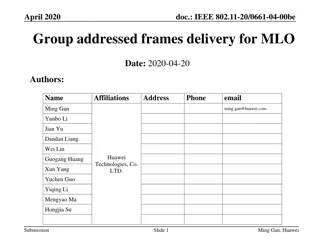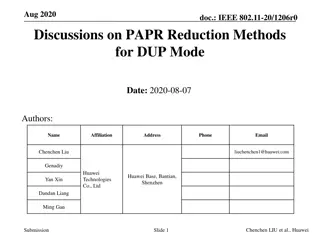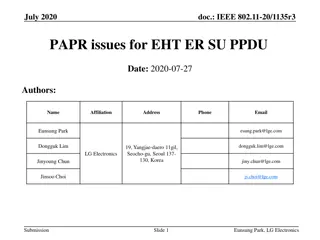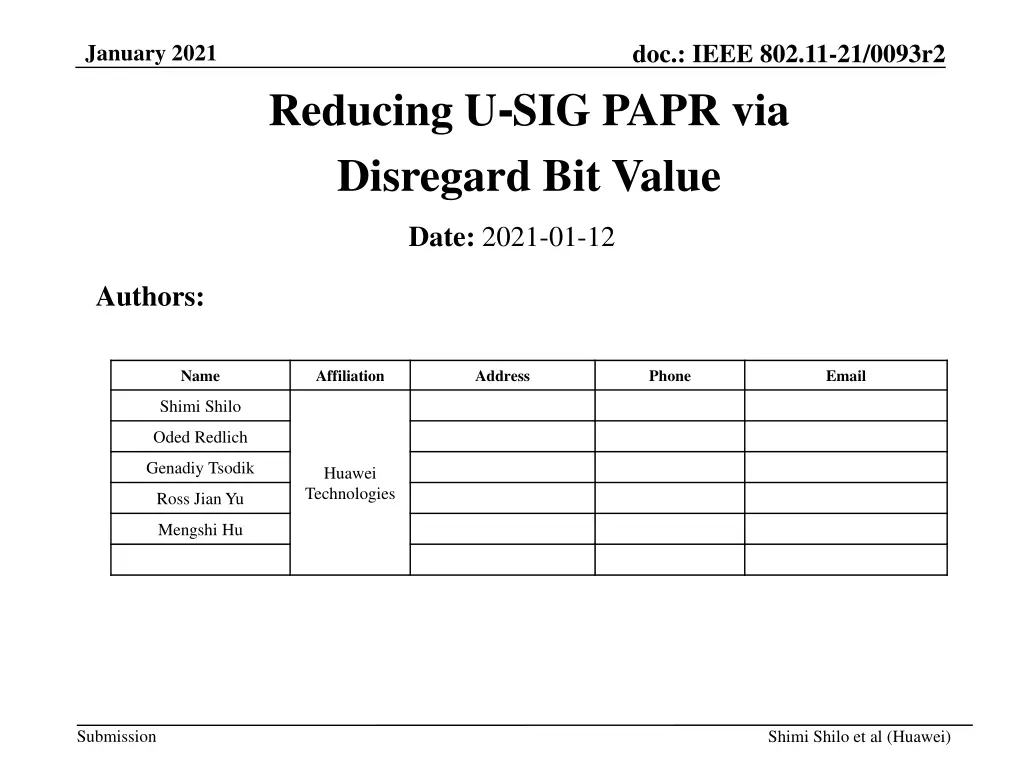
Reducing U-SIG PAPR in IEEE 802.11-21/0093r2
Learn about the methods for reducing Peak-to-Average Power Ratio (PAPR) in U-SIG signals in IEEE 802.11-21/0093r2. Explore the significance of Disregard and Validate bits in maintaining detection performance and signal quality. Understand the implications on PPDU types and signal processing in multi-user scenarios.
Download Presentation

Please find below an Image/Link to download the presentation.
The content on the website is provided AS IS for your information and personal use only. It may not be sold, licensed, or shared on other websites without obtaining consent from the author. If you encounter any issues during the download, it is possible that the publisher has removed the file from their server.
You are allowed to download the files provided on this website for personal or commercial use, subject to the condition that they are used lawfully. All files are the property of their respective owners.
The content on the website is provided AS IS for your information and personal use only. It may not be sold, licensed, or shared on other websites without obtaining consent from the author.
E N D
Presentation Transcript
doc.: IEEE 802.11-21/0093r2 January 2021 Reducing U-SIG PAPR via Disregard Bit Value Date: 2021-01-12 Authors: Name Affiliation Address Phone Email Shimi Shilo Oded Redlich Genadiy Tsodik Huawei Technologies Ross Jian Yu Mengshi Hu Submission Shimi Shilo et al (Huawei)
doc.: IEEE 802.11-21/0093r2 January 2021 Background As of 11be D0.3, the agreed U-SIG design for an MU PPDU is the following: 0 1 2 3 4 5 6 7 8 9 10 11 12 13 14 15 16 17 18 19 20 21 22 23 24 25 U-SIG Sym1 PHY Version Identifier Valid ate BW BSS Color TXOP Disregard DL/UL Version Independent 0 1 2 3 4 5 6 7 8 9 10 11 12 13 14 15 16 17 18 19 20 21 22 23 24 25 U-SIG Sym2 PPDU Type &Compressi Valid ate Valid ate Punctured Channel Indication EHT-SIG MCS Number of EHT-SIG Symbols CRC Tail Bits Version Dependent Similarly, for a TB PPDU the following is current design in D0.3: 0 1 2 3 4 5 6 7 8 9 10 11 12 13 14 15 16 17 18 19 20 21 22 23 24 25 U-SIG Sym 1 PHY Version Identifier BW BSS Color TXOP Disregard DL/UL Version Independent 0 1 2 3 4 5 6 7 8 9 10 11 12 13 14 15 16 17 18 19 20 21 22 23 24 25 U-SIG Sym 2 PPDU Type & Compression Valid ate Spatial Reuse 1 Spatial Reuse 2 Disregard CRC Tail Bits Version Dependent rev1: added data & L-SIG results rev2: consider only valid UL/DL & PPDU Type and Compression Mode values Submission Shimi Shilo et al (Huawei) Slide 2
doc.: IEEE 802.11-21/0093r2 January 2021 Background The Disregard bits are don t care for an R1 device; they may be used to convey information to R2 devices The Validate bits are used by R1 devices to determine whether to terminate reception or not Since it is used to determine PPDU type/BW/color/TXOP etc., the U-SIG detection performance has to be significantly better than the corresponding data detection rate Submission Shimi Shilo et al (Huawei) Slide 3
doc.: IEEE 802.11-21/0093r2 January 2021 Disregard Bit Value In an MU PPDU, the Disregard bits are currently defined as set to 1 In a TB PPDU, the Disregard bits may be copied from the Trigger Frame In 11ax, the reserved bits in HE-SIG-A are also copied from the Trigger frame and are set to 1 Validate bits are also set to 1 Many U-SIG options are not used for example, in a 20MHz PPDU, there are only 14 free bits (out of 26 bits) in the 1st U-SIG symbol of an MU PPDU In the next slide we look at the impact on the U-SIG PAPR Submission Shimi Shilo et al (Huawei) Slide 4
doc.: IEEE 802.11-21/0093r2 January 2021 PAPR Observations We compare the PAPR CCDF of both U-SIG symbols for an MU PPDU with that of the data PAPR (assuming MCS 0), in 20MHz Due to the large number of fixed U-SIG bits, the remaining number of possible combinations is small, and the PAPR curve is not smooth (CLT doesn t apply) Here, the PAPR of the 1st U-SIG symbol exceeds that of the data PAPR in more than 5% of the cases (on average) There are many cases for which U-SIG values will be fixed over time with high PAPR, for example DL+BSS Color=46+TXOP=127 yields ~11dB PAPR Submission Shimi Shilo et al (Huawei) Slide 5
doc.: IEEE 802.11-21/0093r2 January 2021 Potential Solutions We consider here two solutions: Solution #1: Choosing the value of the Disregard bits for each BW and PPDU type Solution #2: Choosing the value of the Disregard bits for each PPDU type (single value for all BW) For the TB PPDU, the single Validate bit can also be copied from the Trigger Frame In the next slides we give more details Submission Shimi Shilo et al (Huawei) Slide 6
doc.: IEEE 802.11-21/0093r2 January 2021 Solution #1 For each PPDU type and BW, we find the Disregard bit sequence that minimizes the PAPR For example, for an MU PPDU and 20MHz BW, choosing a value of 1 0 1 1 0 reduces the PAPR consistently Submission Shimi Shilo et al (Huawei) Slide 7
doc.: IEEE 802.11-21/0093r2 January 2021 Solution #1 cont. For a TB PPDU and 20MHz BW, choosing a value of 0 1 1 1 1 0 to be used in the first U-SIG symbol and 0 1 1 0 1 to be used in the second U-SIG symbol leads to lower PAPR In this case, Validate bit is set to 1 (here value of 1 yields lowest PAPR) A similar approach can be applied to every BW Submission Shimi Shilo et al (Huawei) Slide 8
doc.: IEEE 802.11-21/0093r2 January 2021 Solution #2 Instead of defining a different Disregard sequence for each BW, set a universal sequence for all BW values Simulations show that for an MU PPDU, value of binary 1 0 1 1 0 (decimal 22 ) is a good solution for all BW values For a TB PPDU, value of binary 0 1 1 1 1 0 (decimal 30 ) for the first U-SIG symbol and 0 1 1 0 1 (decimal 13 ) for the second U- SIG symbol is a good solution for all BW values See appendix for more simulation results Submission Shimi Shilo et al (Huawei) Slide 9
doc.: IEEE 802.11-21/0093r2 January 2021 Summary We described the existing U-SIG design, in particular the fact that the Disregard bits are set to all 1s, and showed that this yields a high PAPR Changing the value of the Disregard bits can reduce the PAPR and improve the performance We outlined two simple solutions Our preference is solution #2 defining a single Disregard bits value for each PPDU type Submission Shimi Shilo et al (Huawei) Slide 10
doc.: IEEE 802.11-21/0093r2 January 2021 Straw Poll #1 Do you support to set the default value of the Disregard bits in the U-SIG field of an EHT MU PPDU to 1 0 1 1 0 ( 22 in decimal)? This is for R1 Submission Shimi Shilo et al (Huawei) Slide 11
doc.: IEEE 802.11-21/0093r2 January 2021 Straw Poll #2 Do you support to set the default value of the Disregard bits in the first and second symbols of the U-SIG field, for an EHT TB PPDU, to 0 1 1 1 1 0 and 0 1 1 0 1 , respectively? The default value of the Disregard bits may be defined in the U-SIG field or copied from the Trigger Frame This is for R1 Submission Shimi Shilo et al (Huawei) Slide 12
doc.: IEEE 802.11-21/0093r2 January 2021 Appendix The figure below shows the PAPR CCDF for a 20MHz MU PPDU: Submission Shimi Shilo et al (Huawei) Slide 13
doc.: IEEE 802.11-21/0093r2 January 2021 Appendix The figure below shows the PAPR CCDF for a 40MHz MU PPDU: Submission Shimi Shilo et al (Huawei) Slide 14
doc.: IEEE 802.11-21/0093r2 January 2021 Appendix The figure below shows the PAPR CCDF for an 80MHz MU PPDU: Submission Shimi Shilo et al (Huawei) Slide 15
doc.: IEEE 802.11-21/0093r2 January 2021 Appendix The figure below shows the PAPR CCDF for a 160MHz MU PPDU: Submission Shimi Shilo et al (Huawei) Slide 16
doc.: IEEE 802.11-21/0093r2 January 2021 Appendix The figure below shows the PAPR CCDF for a 320MHz (320-1) MU PPDU: Submission Shimi Shilo et al (Huawei) Slide 17
doc.: IEEE 802.11-21/0093r2 January 2021 Appendix The figure below shows the PAPR CCDF for a 320MHz (320-2) MU PPDU: Submission Shimi Shilo et al (Huawei) Slide 18
doc.: IEEE 802.11-21/0093r2 January 2021 Appendix The figure below shows the PAPR CCDF for a 20MHz TB PPDU: Submission Shimi Shilo et al (Huawei) Slide 19
doc.: IEEE 802.11-21/0093r2 January 2021 Appendix The figure below shows the PAPR CCDF for a 40MHz TB PPDU: Submission Shimi Shilo et al (Huawei) Slide 20
doc.: IEEE 802.11-21/0093r2 January 2021 Appendix The figure below shows the PAPR CCDF for a 80MHz TB PPDU: Submission Shimi Shilo et al (Huawei) Slide 21
doc.: IEEE 802.11-21/0093r2 January 2021 Appendix The figure below shows the PAPR CCDF for a 160MHz TB PPDU: Submission Shimi Shilo et al (Huawei) Slide 22
doc.: IEEE 802.11-21/0093r2 January 2021 Appendix The figure below shows the PAPR CCDF for a 320MHz (320-1) TB PPDU: Submission Shimi Shilo et al (Huawei) Slide 23
doc.: IEEE 802.11-21/0093r2 January 2021 Appendix The figure below shows the PAPR CCDF for a 320MHz (320-2) TB PPDU: Submission Shimi Shilo et al (Huawei) Slide 24



